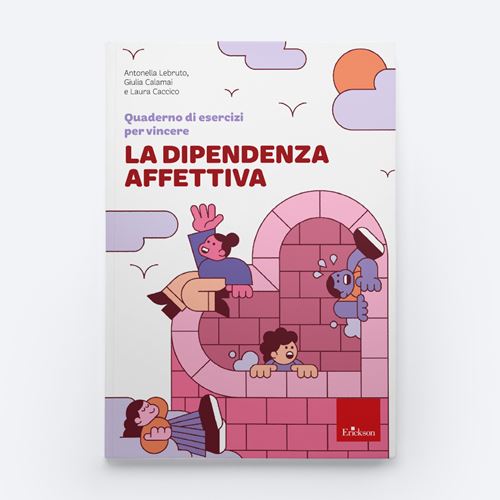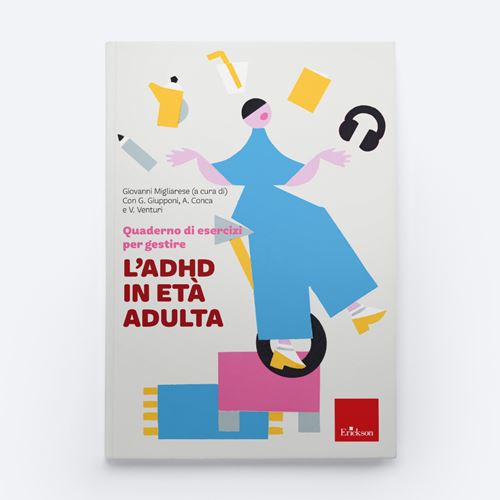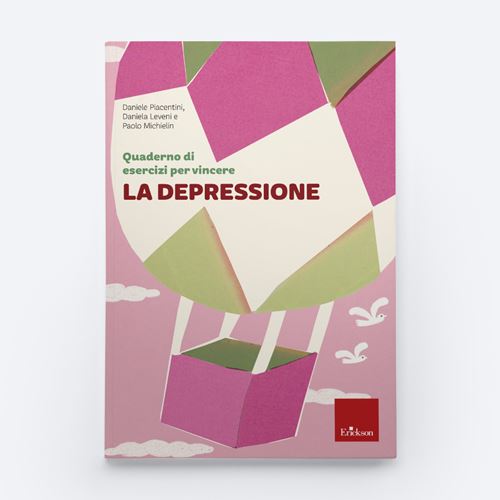Self-help exercise books is a new series of exercise workbooks designed to address
personal psychological disorders through specific and structured exercises that allow you to independently implement strategies and techniques used in
cognitive-behavioural therapy. The workbooks can be used by
those who do not want to, or cannot, face a therapeutic program, but also by
clinicians to provide exercises for their patients.
Each notebook of the series introduces the topic and explains the symptoms from a psychological point of view and suggests a programme of exercises and questionnaires to allow for self-intervention.
The
topics of the workbooks:
- ADHD in adulthood
- Obsessions
- Depression
- Social Anxiety
- Generalised Anxiety
- Emotional dependency
STRUCTURE OF THE WORKBOOKS

Thanks to the use of charts, lists and a detailed insight box, the
first section of the book synthetically and effectively
describes the problem.

In the
second section, an
intervention programme is developed, divided into
a series of steps and full of
effective advice and numerous exercises.

Emotional dependence is a condition in which a person feels unable to live or function without the constant approval, affection, or presence of another. It often leads to unbalanced relationships, fear of abandonment, and difficulty making independent choices. Recognising it is the first step towards building healthier, more autonomous bonds.
This workbook is a
13-step self-help journey, designed to support adults struggling with
emotional dependency. Filled with
practical activities, tips, techniques, and strategies, this book guides readers towards healthier, freer, and more self-aware relationships, helping them to face everyday difficulties with a more realistic and constructive mindset. The ultimate goal: to restore well-being and, in turn, enjoy a more peaceful life.
The workbook is divided into
two parts:
- The first theoretical section provides an overview of the Emotional Dependency, explaining its nature, associated behaviours that might danger people.
- The second part consists of structured exercises across 13 steps.
Exercise workbook to overcome emotional dependency
The 13 steps of the intervention programme:
- Understanding Your Motivation for Change
- Identifying Your Thoughts
- Exploring Your Emotions and Emotional Beliefs
- Recognising Avoidance Strategies and Maintenance Factors
- Assessing and Describing Your Emotional Dependency
- Working on Your Thoughts
- Regulating and Accepting Intense and Unpleasant Emotions
- Riding the Wave of Craving
- Managing Triggers and Seemingly Irrelevant Decisions
- Addressing Your Behaviours and Their Consequences
- Meeting Your Psychological Needs and Expressing Them Assertively
- Changing the Way You Relate to Your Thoughts
- Preventing Relapse
Find out more!

Suffering from Generalised Anxiety Disorder means living in a constant state of worry, which inevitably affects one’s quality of life and sense of personal fulfilment. It’s not just about feeling a little anxious. Everyday problems, no matter how small, can turn into overwhelming fears—whether it’s work, managing finances, family health, or the safety of one’s children.
This workbook offers an
11-step programme to help readers
develop a healthier and more conscious approach to managing excessive worries and the resulting anxiety. It guides them in facing daily challenges with a more realistic, proactive, and functional mindset. The book is packed with advice, techniques, strategies, and exercises aimed at restoring well-being and fostering a calmer, more balanced life.
The workbook is divided into
two parts:
- The first theoretical section provides an overview of Generalised Anxiety Disorder, explaining its nature, associated behaviours, and the most effective therapeutic approaches.
- The second part consists of structured exercises across 11 steps.
Exercise workbook to overcome generalised anxiety
The 11 steps of the intervention programme:
- Recognising and measuring GAD
- Relaxing mind and body
- Undermining the credibility of rumination
- Identifying and counteracting dysfunctional demands
- Protecting self-esteem: core beliefs about oneself
- Modifying dysfunctional behaviours
- Developing a different response to worries
- Is rumination harmful to health?
- Is rumination useful?
- Letting go of rumination and addressing real problems
- Setbacks, regression, and relapses
Find out more!
Leaf through some pages of the book which have been translated into English to facilitate your evaluation of the product.

Attention Deficit Hyperactivity Disorder (ADHD) is a developmental self-regulation disorder that includes difficulties with attention and concentration, impulse control, and the different complexity of the activities. These issues essentially arise from the inability of children, adolescents, or adults to regulate their behaviour in relation to the passage of time, the goals to be achieved, and the demands of the environment.
The Exercise workbook for managing ADHD in adulthood presents a structured journey in 8 steps to help readers recognize the dysfunctional behaviours typical of ADHD and correct them through a series of strategies. This is a self-help book that enables readers to counter their weaknesses and transform them into strengths. The symptoms of Attention Deficit Hyperactivity Disorder that are diagnosed in childhood often persist into adulthood, causing difficulties in many important areas of an adult’s life: e.g. simply organizing time, regulating emotions and managing relationships become frustrating and insurmountable challenges.
Exercise workbook for managing ADHD in adulthood
The 8 steps of the intervention programme:
- Learning to organize time
- Learning to be organized
- Countering the tendency to procrastinate
- Managing emotional dysregulation (impulsivity, mood swings, irritability)
- Organizing study, work, and financial management
- Modifying lifestyle (sleep, nutrition, physical activity)
- Managing relationships with others in family, romantic relationships, and friendships
- Managing «cravings» and addictions
Find out more!
Leaf through some pages of the book which have been translated into English to facilitate your evaluation of the product.
Obsessive Compulsive Disorder (OCD) is a psychiatric disorder, which makes it a real disease. It is mainly characterized by the presence of obsessions, which can generate anxiety or other unpleasant emotions that generally lead those afflicted by it to put compulsions in place to alleviate these feelings.
The Exercise workbook for overcoming obsessions proposes a self-help programme in 16 steps to help those suffering from Obsessive-Compulsive Disorder to identify, understand and manage their symptoms in a conscious and functional way. The effective advice and numerous exercises will guide readers to describe their symptoms, recognize emotional beliefs and dysfunctional thoughts and work on the protective and avoidance behaviours that fuel “their OCD”. The goal is to relieve symptoms, and the suffering associated with them, learning to reduce self-criticism and take care of yourself, in order to improve your quality of life.
Exercise workbook for overcoming obsessions
The 16 steps of the intervention programme:
- Identify obsessions and compulsions
- Cope with unpleasant emotions and emotional beliefs
- Identify avoidance and protective behaviours
- Self-evaluate your OCD
- Recognize dysfunctional thoughts
- Describe the OCD
- Reduce self-criticism
- Distinguish obsessions and normal worries
- Tolerate an excessive sense of responsibility
- Increase risk tolerance and uncertainty
- Learn to tolerate anxiety
- Reassess emotional beliefs
- Reduce problematic behaviours
- Reinterpret obsessions
- Accept the obsessions
- Preventing relapses
Find out more!
Leaf through some pages of the book which have been translated into English to facilitate your evaluation of the product.
The term “depression” has many meanings: it ranges from sadness and temporary despondency to more long-lasting, serious psychological conditions that cause great suffering. It is a disorder that not only affects moods and emotions, but also thoughts and behaviours. People suffering from depression experience great distress, despair and a sense of worthlessness, but thanks to the support of others and the use of effective treatments, it is possible to face and overcome it.
Exercise workbook for overcoming depression offers an 11-step self-help programme to help those who suffer from depression identify, understand and manage their depressive symptoms in a conscious and functional way. The volume is complete with exercises, questionnaires and activities inspired by international guidelines and the principles of cognitive-behavioural psychotherapy. The goal of this book is to reduce the symptoms associated with depression and improve the quality of life of people suffering from it.
Exercise workbook for overcoming depression
The 11 steps of the intervention programme:
- Assess and measure depression;
- Conceptualise your case;
- Modify counterproductive behaviors;
- Address problems in a structured way;
- Identify dysfunctional thoughts;
- Recognise cognitive distortions and question counterproductive thoughts;
- Identify and counteract dysfunctional claims and core beliefs;
- The perverse mechanism of rumination;
- Overcome excessive guilt;
- Strengthen the social network;
- Evaluate progress and prevent relapses.
Find out more!
Leaf through some pages of the book which have been translated into English to facilitate your evaluation of the product.
Social anxiety is a disabling disorder that generates suffering and causes significant limitations in everyday life. It is a frequently underestimated disorder that is interpreted as shyness. Furthermore, those who suffer from it often have difficulty asking for help from a professional, precisely because they are afraid of being judged. Therefore, they refuse to seek any type of support.
Exercise Workbook for Overcoming Social Anxiety offers a 10-step self-help programme for people who suffer from social anxiety, complete with exercises, questionnaires and activities to learn how to manage anxiety, live in a calm and balanced way and overcome the fear of being judged by others.
Exercise Workbook for Overcoming Social Anxiety
The 10 steps of the intervention programme:
- Measuring social anxiety;
- Relaxing your mind and body;
- Comparing expectations and reality;
- Observing thoughts and emotions;
- Questioning your thoughts;
- Questioning your beliefs;
- Limiting inferences and assumptions;
- Confronting your fears;
- Learning to be assertive;
- Preventing relapses.
Find out more!
Leaf through some pages of the book which have been translated into English to facilitate your evaluation of the product.
 EN
EN
 PT
PT


 Thanks to the use of charts, lists and a detailed insight box, the first section of the book synthetically and effectively describes the problem.
Thanks to the use of charts, lists and a detailed insight box, the first section of the book synthetically and effectively describes the problem.
 In the second section, an intervention programme is developed, divided into a series of steps and full of effective advice and numerous exercises.
In the second section, an intervention programme is developed, divided into a series of steps and full of effective advice and numerous exercises.











